Top Leading Benefits of AI in Education for Teacher and Student

Schools everywhere are exploring the benefits of AI in education, from smarter grading to personalized learning. But how can technology truly support teachers without replacing them? This guide of MOR Software will show the most effective ways to integrate AI into classrooms while keeping human connection and creativity at the center.
What Is AI In Education?
AI in education uses computer systems that can think and learn like humans to make learning better for everyone. It helps teachers manage daily work and improves how students study. These tools, which include evolutionary algorithms, natural language processing, and robotics, can adjust lessons to match each student’s learning speed and ability. This smart setup supports different learning styles and helps every learner get what they need to grow. It also shows clearly what are the benefits of AI in education when applied in real classrooms.
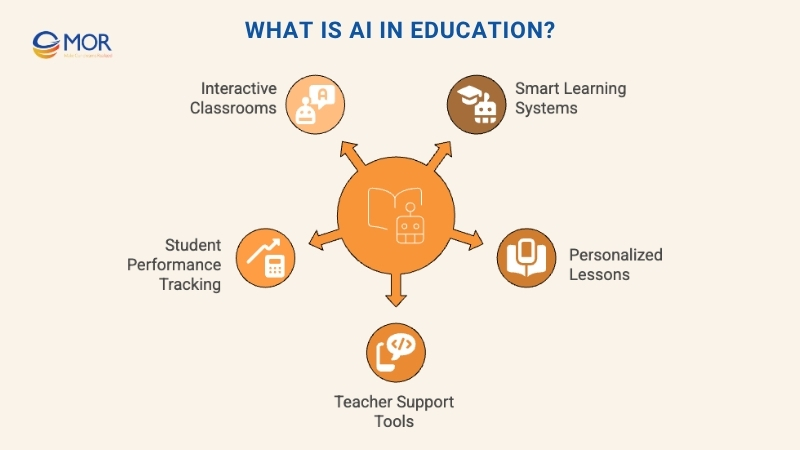
Besides personal learning support, these systems can take care of administrative tasks that usually take up a teacher’s time. Teachers can then spend more time helping students and building stronger lessons. AI automation suggester can also track performance and progress, giving early signals when a student needs help or when someone performs well. With this data, schools can make smarter choices and improve results for everyone.
The growing benefits of AI in education are also seen in new ways of teaching. It helps create interactive and engaging classrooms where students can learn through smart activities and instant feedback. As these tools improve, the education field will continue to grow more flexible, inclusive, and focused on personal success.
Traditional Classroom Vs. AI-Powered Classrooms
Education is shifting from one-size-fits-all teaching to more dynamic, data-driven learning. The comparison below highlights how traditional classrooms differ from AI-powered ones in creating more personalized and engaging experiences for students.
Aspect | Traditional Classroom | AI-Powered Classroom |
Teaching Method | Mostly lecture-based and the same for everyone | Focused on adaptive and personalized learning that reflects the benefits of AI in education |
Student Engagement | Often passive, with limited interaction | Interactive and engaging through real-time feedback and smart activities |
Assessment | Standard tests given a few times each term | Ongoing assessment with instant feedback that tracks growth continuously |
Learning Pace | All students move at the same speed | Each learner studies at their own pace with guidance from AI tools |
Access to Resources | Learning materials mainly in books and printed handouts | Digital libraries and online systems that expand AI in education benefits for all users |
Feedback | Results shared after long grading periods | Immediate updates on performance, helping students improve faster |
Curriculum | Fixed lessons with little flexibility | Courses that adjust to each student’s progress and personal goals |
Data Utilization | Limited data use in teaching | Smart analytics help teachers understand what works and what needs change |
Skill Development | Focus on memorization and exams | Promotes creative thinking, problem-solving, and digital skills |
Accessibility | Learning only happens in the classroom | Students can study anywhere with an internet connection |
Teacher Workload | Heavy workload from grading and paperwork | AI tools help reduce teacher effort and improve productivity |
Top 10+ Leading Benefits Of AI In Education
AI is transforming classrooms into smarter, more adaptive learning spaces. Below are the most significant ways this technology is improving how teachers teach and how students learn every day.

1. Smarter Learning Paths Tailored To Each Student
One of the main benefits of AI in education is how it personalizes learning for every student. Traditional lessons often use the same plan for all learners, but each student has different skills, knowledge, and study speed. AI automation can analyze these factors to create lessons that fit each learner’s needs while teachers still guide the process. This is one of the most practical benefits of using AI in education in modern classrooms.
Smart learning platforms can check progress in real time and adjust difficulty to match a student’s current level. Students no longer feel bored with simple tasks or stressed with material that feels too hard. For instance, some AI tools for math can change problem levels automatically based on how well a student performs.
These systems can also help teachers organize lessons more effectively. The platform identifies learning gaps and offers personalized recommendations, so teachers can focus on meaningful feedback instead of repetitive planning.
Schools using adaptive AI systems have noticed better engagement and results because lessons are now matched to student strengths and weaknesses. Teachers can see progress clearly, spot challenges faster, and guide students toward steady improvement. This shows how AI in education supports both teachers and students in achieving stronger learning outcomes.
2. Faster Grading And Real-Time Student Feedback
Another key benefit of AI in education is how it changes the grading and feedback process. Smart tools can review assignments quickly and give students detailed comments right after they finish their work. This faster turnaround keeps learning active while teachers stay in control of the review process.
This immediate feedback helps students learn from mistakes while the lesson is still fresh in their minds. Instead of waiting days for results, they can see where they went wrong and fix it right away. This constant feedback cycle supports faster progress and deeper understanding.
Modern AI systems can handle different types of assessments, including multiple-choice, essays, and creative writing. They can also explain why an answer is incorrect and suggest ways to improve it. These tools bring flexibility to evaluation and show clear examples of the benefits of AI in education for both teachers and students.
Saving time on grading gives teachers more space to focus on personal guidance and lesson quality. Long hours of checking papers can be reduced, letting educators spend more time mentoring and supporting students. With AI handling the routine work, teachers can keep their attention on what truly matters in the classroom: human connection and quality learning.
3. Breaking Down Learning Barriers
Another major benefit of AI in education is its ability to create classrooms where every learner feels included. It helps reduce challenges caused by disabilities or language differences and supports teachers in reaching students who need extra help. These solutions highlight the positives of AI in education for building fair and accessible learning spaces.
Support for Visual Impairments
Students with vision problems can study more independently using AI-based speech-to-text and text-to-speech tools. Some learning apps now include computer vision that helps students recognize objects, read printed text aloud, and move safely around their surroundings. This technology is even improving in turning math equations into formats that screen readers can understand, giving blind students better access to complex lessons.
Speech and Communication Help
AI-powered systems can also assist students with speech difficulties. Through advanced AAC tools, partial words or gestures can be translated into full sentences, helping learners express themselves more clearly and join class discussions confidently.
Language Support
AI-based translation tools are closing communication gaps for non-native speakers. Platforms that support multiple languages help ensure all students can access lessons without long delays. These features show how AI in education can remove barriers and give every learner a fair chance to succeed.
4. Boosting Classroom Engagement Through AI
A growing benefit of AI in education is how it helps teachers create more engaging and interactive lessons. Instead of using the same worksheets and slides for everyone, AI agent frameworks make it easier to add challenges, visuals, and fun activities that fit each student’s learning style. Lessons become more personal, lively, and motivating.
Modern learning platforms now include points, badges, and reminder systems to keep students focused and excited. These small incentives help maintain the right balance between challenge and success, which keeps motivation high without adding stress.
Many AI-powered tools also allow teachers to design their own learning games and interactive materials, even without coding skills. For example, creative platforms like Canva AI let teachers build mini-games, quizzes, or visual aids that suit different preferences. This flexible design approach helps educators discover how students learn best and adjust lessons to match.
When engagement increases, students tend to finish more tasks, remember more information, and participate with greater enthusiasm. This makes AI in education a valuable tool for turning classrooms into active spaces where curiosity and creativity grow naturally.
5. 24/7 AI Tutoring For Extra Learning Support
A valuable benefit of AI in education is its ability to give students ongoing help even after school hours. Teachers can’t always be available, but AI-powered tutors can fill that gap by offering guidance across subjects like math, science, and writing. These digital assistants can support many learners at once, answering questions and explaining key ideas clearly.
AI tutoring systems can spot where a student is struggling and offer step-by-step explanations to clear up confusion. For instance, when a learner gets stuck on quadratic equations at night, the system can walk them through the solution instead of waiting until the next class. This extra help shows how does AI help students learn in a more flexible and responsive way.
Such tools are especially helpful for shy students or those who study at different times. They can ask questions freely and get quick feedback, which improves homework completion and builds confidence.
AI tutoring also helps teachers focus on what really needs their attention. While the system handles basic practice and common questions, teachers can spend more time mentoring, solving complex problems, and supporting personal growth. Together, this balance makes learning both efficient and deeply human.
6. Identifying At-Risk Students Early
One of the most practical benefits of AI in education is its ability to help teachers spot learning problems before they become serious. Many educators know the surprise of seeing a student’s poor grade with no early warning. AI systems can prevent that by analyzing patterns in homework, quizzes, and classroom activity that might be easy to overlook.
These platforms review classroom data and highlight students who may be struggling to keep up. They track details like time spent on tasks, question patterns, and how often a student needs corrections. With this insight, teachers can understand who is improving and who might need extra help.
This proactive method supports early intervention and closes learning gaps faster. Students who start behind can get help sooner instead of waiting for final test results. Information sets used in machine learning nyt make it easier to act early, giving teachers time to respond with care and create stronger learning outcomes for every student.
7. Reducing Teacher Workload With AI Tools
A clear benefit of AI in education is how it helps teachers save time on repetitive administrative work. Tasks like writing reports, replying to parent emails, and tracking attendance often take hours that could be spent teaching. AI-powered tools can handle these activities faster and more accurately, giving teachers back valuable time while keeping communication professional and personal.
Smart platforms now help automate lesson plan outlines, generate student progress reports, and even prepare parent updates with a natural tone. Instead of spending half an hour writing each message, teachers can send customized notes in minutes. These small time savings add up quickly and help lower daily stress levels.
AI also supports managing schedules, grading smaller tasks, and tracking attendance without extra paperwork. This not only improves productivity but also allows teachers to focus more on classroom interaction. Many educators see the benefits of AI for teachers in creating a better balance between teaching and administration, helping them stay motivated and connected to their students.
8. Benefits Of AI In Education For School Leadership
One of the growing benefits of AI in education is how it supports school leaders in making faster and smarter decisions. With real-time data from classrooms, administrators can now see performance trends as they happen instead of waiting for monthly or quarterly reports. This improvement helps schools plan resources, guide teachers, and support students more effectively.
AI-driven dashboards allow leaders to monitor activity across subjects and track how machine learning models are being used. They can spot early warning signs, measure student progress, and see which areas need extra attention. By combining data from assignments, attendance, and engagement, schools gain a clear picture of overall performance that single reports often miss.
This data-driven approach empowers leadership teams to act with confidence. They can identify programs that boost engagement, address learning gaps quickly, and decide how to invest in technology or training. The result is a smarter, more responsive education system where every decision is guided by accurate, up-to-date information.
9. AI In Curriculum Design And Improvement
Another strong benefit of AI in education is how it reshapes the way schools create and improve their curriculum. AI tools can review learning data across different lessons to see which materials help students learn better. This insight allows teachers to adjust content based on real results instead of guesswork. It also highlights one of the key benefits of generative AI in education, where technology can assist in building better learning resources.
Many digital platforms can now create question banks, summaries, and lesson templates aligned with academic standards. These ready-made materials save teachers time and let them focus on refining lessons to meet student needs. AI also helps personalize learning by tracking progress and showing which topics need extra practice or support.
Teachers can use analytics to compare which resources lead to stronger engagement and improvement. Adapting the curriculum using these insights keeps lessons relevant and effective throughout the school year.
This approach shifts education from simple content delivery to real skill building. With AI’s help, schools can prepare students not only for exams but also for the modern workplace, where adaptability and problem-solving matter most.
10. Personalized Professional Development For Teachers
A growing benefit of AI in education is how it supports teachers in improving their own skills. Educators often struggle to find time for training or research because of heavy daily workloads. AI tools help close that gap by acting like personal teaching assistants that analyze classroom data and recommend learning resources that fit current challenges.
For example, when students have trouble understanding fractions, an AI system might suggest lessons using visual or hands-on methods. If attention drops during science class, it could recommend new strategies to spark curiosity. This makes professional learning more practical and linked directly to classroom needs.
Smart educational platforms track engagement, lesson effectiveness, and assessment results to offer short, focused suggestions. These quick modules, often designed for micro-learning, make it easier for teachers to pick up new techniques during short breaks and apply them right away.
With this approach, teachers stay in control of their growth. AI simply guides them toward relevant skills that enhance student success, making professional development more meaningful and accessible.
11. Supporting Work-Life Balance And Preventing Burnout
One of the often-overlooked benefits of AI in education is how it helps teachers manage their workload and reduce stress. Administrative duties like reports, emails, and scheduling can take up hours that should be spent teaching or resting. AI-powered assistants can now handle many of these repetitive jobs, giving teachers more time to focus on meaningful classroom work.
Smart platforms help organize lesson plans, track attendance, and create progress reports automatically. They also adapt to each teacher’s preferences, making routine communication and planning faster and smoother. This shows how technology can improve efficiency without replacing the human side of teaching.
Many educators recognize that using machine learning algorithm can help maintain a healthier work-life balance. When teachers have more time for rest and reflection, they bring more energy and creativity to their lessons. A well-supported teacher is more likely to stay motivated, engaged, and effective in the long run.
Starting small can make a big difference. Try using AI to manage one time-consuming task this semester and see how it improves both your productivity and your personal well-being.
5 Case Studies Showing Benefits Of AI In Education
The growing use of AI is changing how schools and teachers prepare students for the future. The following five real examples from the Shaping the Future of Learning report highlight how the benefits of AI in education are improving equality, engagement, and learning results around the world.
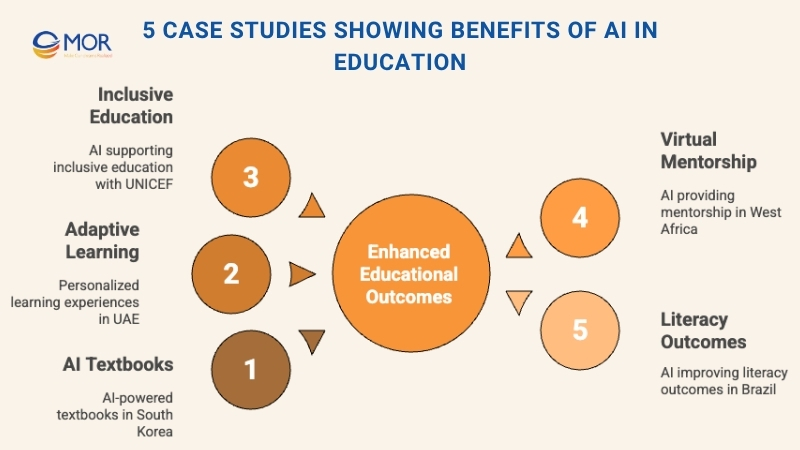
AI Textbooks Revolutionize Learning In South Korea
South Korea’s Ministry of Education has announced plans to introduce AI-driven digital textbooks in primary and secondary schools beginning in 2025. This move aims to reduce learning gaps, limit dependence on private tutoring, and ease the pressure created by the country’s competitive education system.
These AI textbooks will deliver personalized learning experiences, allowing students to study at their own pace. The initial rollout will focus on mathematics, English, and informatics before expanding to all subjects. Teachers and AI will work together to provide balanced instruction that adapts to individual learning needs.
In a panel discussion about the benefits of AI in education, Gaspard Twagirayezu, Rwanda’s Minister of Education, highlighted that AI can assess each student’s ability and tailor content accordingly. This blend of technology and human teaching is shaping a more inclusive and effective learning environment for the next generation.
Adaptive Learning Success In The UAE
The Ministry of Education in the United Arab Emirates is launching an initiative focused on equal learning opportunities for all students. This project uses multimodal AI models to deliver lessons tailored to each learner’s ability and pace, reflecting the growing benefits of generative AI in higher education.
The AI tutor adjusts lessons based on how students learn best, offering the right level of guidance and feedback. It continuously tracks performance, provides personalized study materials, and suggests next steps to strengthen understanding. Teachers can also access real-time analytics to plan adaptive strategies that match each learner’s progress.
Automating routine teaching tasks allows educators to concentrate on interactive and creative parts of the lesson. Early results from a pilot version have already shown a 10% improvement in academic performance, confirming that AI-driven personalization can make learning more engaging and effective.
Inclusive Education Through AI And UNICEF
AI is becoming a key tool in making classrooms more inclusive and accessible for every learner. According to the World Economic Forum, around 240 million children worldwide live with disabilities, and many still lack access to proper learning materials or supportive technologies. To address this, UNICEF is developing AI-powered digital textbooks designed for diverse learners, further highlighting the benefits of AI in education for accessibility.
These digital textbooks allow customization based on each student’s needs. They include sign-language videos, interactive lessons, audio descriptions, and text-to-speech options, helping students with different abilities participate equally in class. Learners can also download and use the materials offline, which is crucial in areas with limited internet access.
Deemah Al Yahya, Secretary-General of the Digital Cooperation Organization, emphasized that millions of people still live without basic connectivity. In such contexts, AI-supported offline solutions offer real hope for inclusion, ensuring that no child is left behind in the learning process.
Virtual Mentorship In West Africa
In Mali, an education start-up called Kabakoo Academies is using AI to help young people build real-world skills in regions where formal jobs are limited. With more than 80% of Africa’s workforce in informal employment, this initiative shows how the benefits of AI in education can extend beyond classrooms to improve livelihoods.
Kabakoo combines hands-on learning with digital mentoring. Through its mobile app, learners gain 24/7 access to an AI mentor that provides personalized guidance, feedback, and study materials. The mentor supports students whenever they need help, even outside traditional study hours, fostering self-directed learning and confidence.
The results speak for themselves. Graduates have reported a 44% increase in income just six months after completing the program, proving how AI-powered mentorship can create meaningful opportunities and long-term growth for young learners.
Improving Literacy Outcomes In Brazil
In response to Brazil’s low performance in recent OECD PISA rankings, the Letrus program is using AI to strengthen literacy across middle and high schools. The initiative focuses on reducing the learning gap between students from low- and high-income backgrounds, showing how the impact of AI on education can help create fairer opportunities for all learners.
Letrus applies personalized learning powered by AI to give students real-time feedback on writing tasks. Teachers and school leaders receive detailed progress reports and targeted suggestions for each class, helping them guide students more effectively.
The results have been promising. Schools in Espírito Santo have reported strong improvements in writing exam scores, leading the state to adopt Letrus as its official literacy development program.
The World Economic Forum’s Shaping the Future of Learning 2024 report notes that AI has great potential to transform education and prepare learners for future job markets. It also reminds educators that while these advances bring clear benefits, strong policies and careful implementation are essential for safe and lasting success.
>>> In the rapidly advancing era of AI, many businesses face barriers from the very beginning due to a lack of foundational knowledge. Mastering 40 AI terms explained enables all departments within an organization to communicate consistently and accelerate AI strategy execution. Let's explore!
Practical Applications Of AI In Education
The real-world benefits of AI in education can be seen in how technology is reshaping the way students learn and teachers teach. Modern EdTech platforms now use AI to adapt lessons to individual needs, making learning more flexible and personalized. Global technology leaders and IT consulting firms are creating AI-powered education tools that improve interaction, understanding, and outcomes. Below are some examples of how AI is being used effectively in classrooms today.
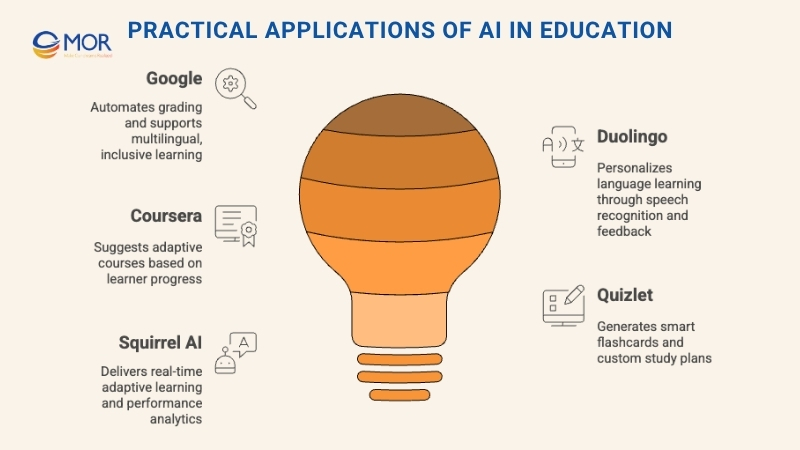
Google has become a leader in developing tools that simplify and improve education through AI. Google Classroom helps teachers assign work, share resources, and manage communication efficiently. It also uses AI algorithms to automate grading, recommend personalized study materials, and track student progress. This makes teaching more focused and data-driven.
Other Google products also show the wide AI in education benefits for learners worldwide. Google Translate helps remove language barriers, providing instant translations for text, websites, and speech. Google Scholar, on the other hand, uses AI to organize research materials and academic papers, helping students and educators quickly find reliable sources. Together, these tools make learning more inclusive, accessible, and effective for everyone.
Duolingo
Duolingo, one of the world’s most popular language-learning platforms, uses AI to create personalized and flexible lessons for every learner. Its AI engine tracks user progress, identifies weak areas, and adjusts lessons in real time to improve results.
The app delivers tailored exercises, vocabulary practice, and interactive quizzes that help users build confidence and fluency step by step. Through smart speech recognition and instant pronunciation feedback, Duolingo also supports more accurate speaking skills. These features show how the benefits of AI in education extend to language learning, making it easier, more engaging, and accessible for students everywhere.
Coursera
Coursera applies AI technology to make online education more personalized and effective. Its system analyzes each learner’s goals and performance to suggest the right courses and create adaptive study paths that evolve with their progress.
Through automated assessments and real-time feedback, Coursera helps students understand concepts more deeply and correct mistakes immediately. The platform’s AI engine adjusts lessons based on engagement and results, ensuring that every learner follows a path suited to their pace and skill level. These innovations highlight the benefits of AI in education, especially in large-scale online learning where personal guidance can be limited.
Quizlet
Quizlet, a global study and learning platform, uses AI to make studying smarter and more efficient. Its adaptive “Learn” mode creates personalized study plans by analyzing what students already understand and what they still need to improve.
The platform adjusts question difficulty and format based on performance, ensuring each study session is focused and productive. It also uses AI to automatically generate practice tests and interactive flashcards that match each learner’s goals. Through these tools, Quizlet demonstrates the practical benefits of AI in education, helping students stay motivated and learn more effectively with every session.
Squirrel AI
Squirrel AI is one of the first global EdTech companies to bring large-scale adaptive learning powered by artificial intelligence into classrooms. Its system continuously evaluates each student’s knowledge, progress, and learning habits to create a personalized path that fits their exact level and pace.
Through real-time analysis, Squirrel AI identifies knowledge gaps and predicts learning outcomes, allowing students to strengthen weak areas and reach mastery faster. Teachers also receive detailed insights into class performance, making instruction more focused and effective. This approach highlights the powerful benefits of AI in education 10 points, showing how adaptive technology can improve both teaching precision and student achievement.
Challenges And Limitations Of AI In Education
As AI becomes more common in schools and universities, its role is met with both excitement and caution. While the benefits and challenges of AI in education are widely discussed, the key lies in finding balance. The technology can improve learning outcomes, but it also brings risks that must be managed carefully to create a safe and fair educational environment.
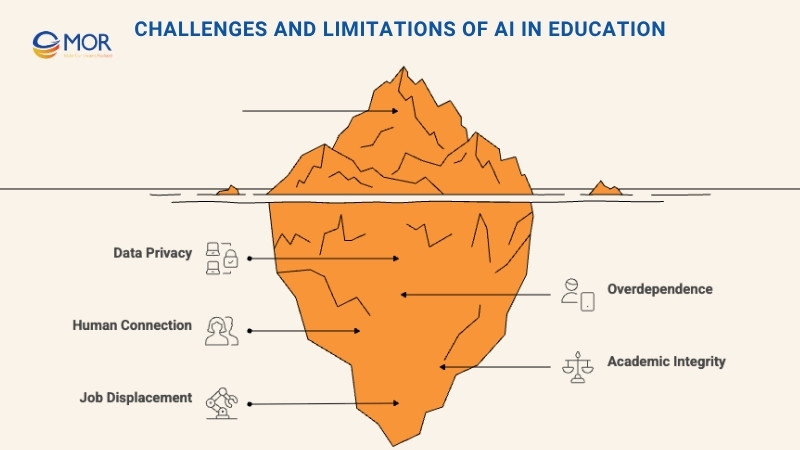
Data Privacy And Security
A major concern with using AI in classrooms is protecting student data. These systems rely on large amounts of information, such as academic results, behavior patterns, and sometimes even voice or facial data, to function well. Collecting and storing so much personal information can create serious privacy risks.
If security measures are weak, sensitive data could fall into the wrong hands, leading to breaches or identity theft. Schools and tech providers must apply strict data protection policies and follow legal standards to keep information safe. Managing privacy responsibly ensures that the benefits of AI in education do not come at the cost of student security.
Overdependence On Technology
Another key limitation of AI in education is the increasing reliance on technology for everyday teaching and management. As schools use more AI-based systems for grading, lesson planning, and communication, the risk of depending too heavily on these tools grows. When systems fail or face cyberattacks, learning can be disrupted, and schools may struggle to operate smoothly.
There’s also a concern that students might rely too much on AI for quick answers instead of thinking critically or solving problems on their own. If used without balance, technology could reduce creativity and independent learning. To fully gain the benefits of AI in education, teachers must continue to guide students in building real-world reasoning skills while using AI as a service tool, not a replacement.
Loss Of Human Connection
One of the biggest concerns about AI in education is the reduced human interaction it can bring. In traditional classrooms, teachers do more than deliver lessons. They motivate, listen, and guide students emotionally. AI tools, while helpful, cannot replace the empathy and personal understanding that come from real human contact.
When learning becomes too automated, students may feel isolated or less emotionally connected to their studies. This can weaken social skills, teamwork, and motivation. To keep the benefits of AI in education meaningful, schools should blend technology with genuine human interaction, ensuring that emotional growth remains part of every student’s learning experience.
Academic Integrity Risks
Another growing concern with AI in education is the increased potential for cheating. While AI can support learning, it can also be misused to produce or alter content that appears original. Some students may use advanced tools to generate essays or solve assignments automatically, making it harder for teachers to assess true understanding.
Even plagiarism detection systems powered by AI can sometimes be fooled by newer, more sophisticated tools that create human-like text. In addition, automated tutoring and testing systems may be exploited to gain unfair advantages. To preserve trust in academic results, schools must regularly update their technologies, train educators to spot AI misuse, and promote a strong culture of honesty in learning.
Fear Of Job Displacement
The growing use of AI in education has also raised concerns about teachers being replaced by machines. As AI tools become more capable of handling grading, tutoring, and administrative work, some worry that the role of teachers could shrink or lose value. This fear of automation affecting jobs is shared across many fields, but in education, it carries special weight because teaching is deeply personal and relational.
While technology can improve efficiency, it cannot replace the empathy, creativity, and real-time judgment that teachers bring to the classroom. AI should be seen as a supportive partner, not a replacement. Maintaining balance ensures that educators remain central to the learning process, guiding students in ways that no algorithm can replicate. This human connection remains one of the most important benefits of AI in education when used responsibly.
What Is The Cost Of Developing AI Solutions For Education?
The cost of building an AI-based education app typically ranges from $30,000 to $300,000 or more, depending on the scope and requirements of the project. This figure is only an estimate, as the actual price varies based on factors such as app complexity, selected features, UI/UX design quality, the development team’s location, platform choice, and the technology stack used.
We’ve introduced a quick overview of the estimated timeline and pricing for different levels of AI education app development:
App Complexity | Estimated Timeline | Estimated Cost |
Basic app with limited features | 4–6 months | $30,000–$50,000 |
Mid-level app with moderate functionality | 4–9 months | $50,000–$120,000 |
Advanced platform with custom AI integration | 9 months to 1 year or longer | $120,000–$300,000+ |
These figures serve as a general guide to help you plan budgets effectively. For businesses or schools exploring the benefits of AI in education, investing in the right features, scalable architecture, and user-friendly design can lead to stronger engagement and long-term returns on investment.
Key Questions Before Implementing AI In Schools
Before bringing AI into classrooms, schools need thoughtful preparation to make the transition smooth. Asking the right questions first helps educators apply technology effectively and keep learning goals in focus.
- Is your tech infrastructure ready for AI platforms? Make sure your school has enough devices, stable internet, and a system that works well with AI tools. Without this foundation, it’s difficult to use the benefits of AI in education effectively.
- Have teachers received proper AI training? Technology alone doesn’t improve classrooms. Without proper training, it can increase workload instead of saving time. Ongoing professional development ensures that teachers know how to use AI confidently and productively.
- How will you ensure data safety and privacy? Before introducing AI, set clear policies for data storage, usage, and security. Be mindful of ethical concerns, including bias in algorithms and transparency in how AI decisions are made.
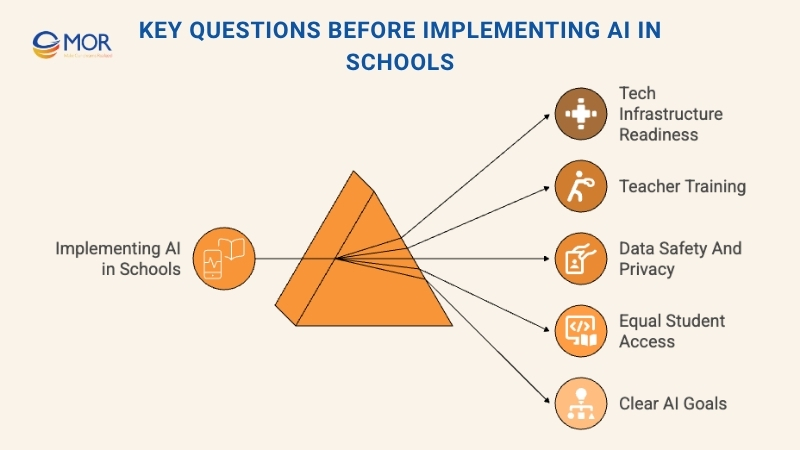
- Are all students guaranteed equal access? Not every student has the same access to digital tools. Schools should provide fair opportunities so all learners benefit equally from AI-based education, regardless of background or resources.
- What goals do you want AI to achieve? Define what you want AI to achieve, such as improved learning outcomes or reduced administrative work. Having specific targets helps schools measure whether AI is truly improving education.
Steps To Integrate AI For Smarter Learning And Management
Successfully applying the benefits of AI in education requires a clear, structured approach. Schools and institutions need to plan carefully to make sure AI adds real value to both teaching and administration. Below are key steps to guide a smooth and effective integration process.
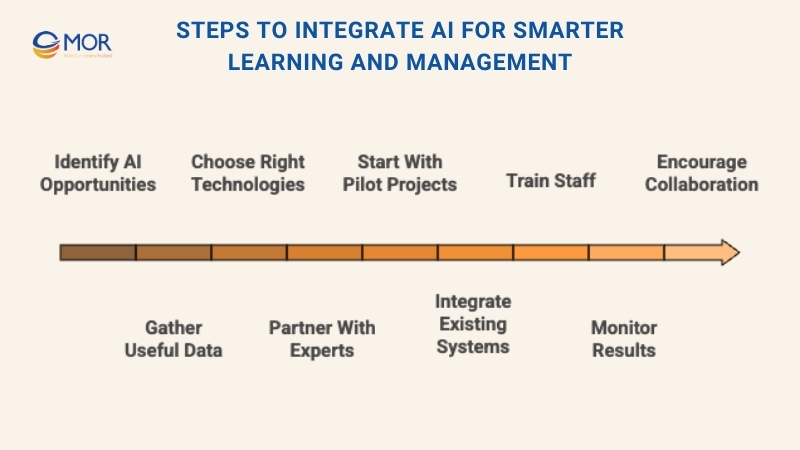
- Identify where AI can help most. Look for specific areas such as grading, student support, or administrative automation where technology can improve outcomes.
- Gather and analyze useful data. Collect information from student performance reports, curriculum materials, and internal systems to gain insights that guide better decision-making.
- Select the right AI technologies. Use machine learning for personalization, natural language processing (NLP) for chatbots and virtual assistants, and computer vision for automated grading or content recognition.
- Partner with an experienced AI development firm. Collaborate with professionals who can build custom solutions suited to your school’s needs and goals.
- Start with a pilot or MVP project. Test the system in real classrooms before expanding to a full-scale rollout.
- Integrate AI into existing platforms. Ensure your learning management systems and databases connect smoothly with the new tools.
- Train teachers and staff. Comprehensive training helps educators understand how to use and manage these systems effectively, strengthening the benefits of generative AI in education.
- Monitor and refine. Track performance, collect feedback, and adjust the technology to improve results over time.
- Promote collaboration. Encourage teachers, developers, and researchers to share experiences and best practices that help advance AI-driven education.
The Future Outlook Of AI In Education
The future of AI in education looks promising and full of change. This technology is reshaping how teachers teach and how students learn, leading to a more flexible and data-driven education system. Through advanced algorithms, AI can study large amounts of information and create adaptive, personalized learning paths that meet the unique needs of each student. Learners receive instant feedback, customized lessons, and even access to immersive experiences powered by augmented and virtual reality in education.
Conversational tools and intelligent tutoring systems also play a growing role. They offer real-time help, track learning behavior, and guide students through lessons independently. These tools are especially valuable for distance learning and corporate training, where flexibility and accessibility matter most.
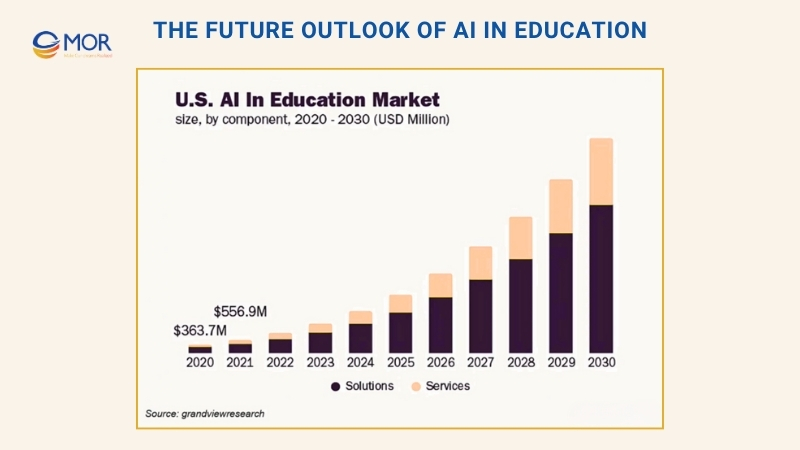
Modern AI trends are making classrooms more interactive and engaging through personalized courses, gamified lessons, and adaptive assessments. With growing investment in EdTech, the global AI education market is projected to exceed $32.27 billion by 2030, showing how strong the impact of AI on education will continue to be.
Governments and organizations such as UNESCO and the U.S. Department of Education now emphasize responsible AI use to ensure data protection and transparency. Major companies are following this direction, too. For instance, OpenAI launched ChatGPT Edu in May 2024, a secure version built for universities and colleges, highlighting AI’s expanding role in safe, ethical education.
With these ongoing advancements, AI will continue to create more engaging, inclusive, and personalized learning experiences, transforming education into something smarter and more human-centered than ever before.
Leverage The Benefits Of AI In Education With MOR Software
MOR Software empowers education providers to unlock the real benefits of AI in teaching, learning, and administration. We design intelligent platforms that make education more personalized, efficient, and accessible for everyone. With strong expertise in AI outsourcing, cloud, and mobile technologies, our team builds scalable systems that adapt to each learner’s needs and streamline institutional workflows.
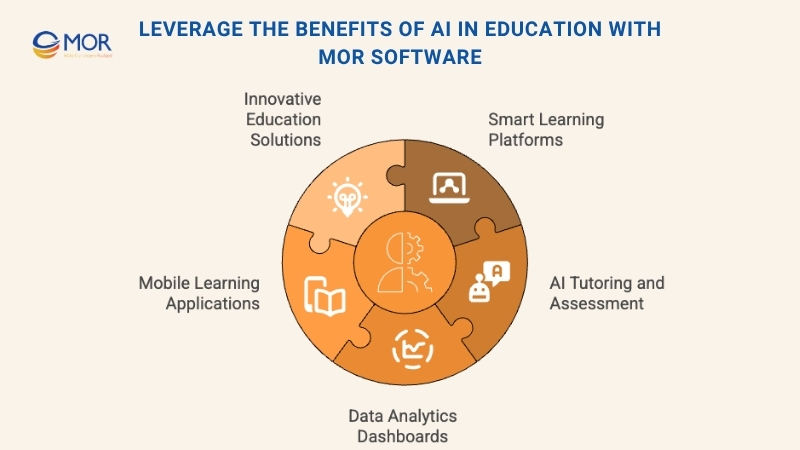
We deliver:
- Smart learning platforms that personalize lessons and analyze performance data in real time.
- AI-based tutoring and assessment tools that provide instant feedback while reducing teacher workload.
- Data analytics dashboards that support faster, evidence-based decisions.
- Mobile and web applications that enhance learning experiences anytime, anywhere.
Backed by years of experience and global success stories, MOR continues to help schools, universities, and EdTech companies transform learning through innovation. Contact us to explore your next AI-driven education solution.
Conclusion
AI is changing the way teachers teach and students learn, proving that the benefits of AI in education go far beyond convenience. From smarter learning tools to real-time analytics, it’s helping schools deliver better results with less effort. As this technology continues to evolve, partnering with experts makes all the difference. Contact MOR Software today to explore tailored AI solutions that enhance learning, empower educators, and prepare your institution for the future.
MOR SOFTWARE
Frequently Asked Questions (FAQs)
What are the main benefits of AI in education?
AI helps students receive instant, personalized feedback on their work, highlighting areas of strength and weakness. This process improves learning outcomes and allows teachers to focus on targeted instruction. AI also supports content creation, lesson planning, and student performance analysis for more effective teaching.
How does AI improve learning for students?
AI tailors lessons to each student’s pace and understanding. Virtual tutors and intelligent platforms provide round-the-clock support, making study sessions more efficient. Students can access adaptive exercises, automatic grading, and real-time explanations that strengthen comprehension and engagement.
How is AI transforming education today?
AI makes learning more interactive by generating custom content that fits each student’s level and interests. It also helps teachers analyze classroom data to design better learning strategies and keep students motivated through adaptive feedback and engaging digital tools.
Can AI improve student performance and outcomes?
Yes. AI-driven analytics help educators track progress, predict academic risks, and identify learning gaps early. Schools use these insights to adjust teaching methods, provide timely intervention, and improve overall student achievement rates.
How has AI benefited students directly?
Students gain access to personalized learning experiences, 24/7 tutoring, and instant feedback. AI simplifies complex subjects, supports multiple learning styles, and offers accessibility tools like translation and text-to-speech for inclusive education.
What are the top five advantages of using AI in education?
- Personalized learning for every student
- Faster grading and feedback
- Improved accessibility for diverse learners
- Smart data analysis for better decisions
- Enhanced engagement through interactive learning experiences
How do students use AI tools in school?
Students rely on AI-powered apps to plan projects, understand complex concepts, and get step-by-step help from virtual assistants. These tools simplify problem-solving and make self-learning easier through real-time guidance and instant information access.
Can AI replace teachers in the future?
No. AI supports teachers by automating repetitive work like grading and scheduling, but it cannot replace human empathy, mentorship, or creativity. Teachers remain essential for emotional guidance, critical thinking, and building meaningful relationships with students.
How does AI support teachers in the classroom?
AI reduces administrative workload, automates lesson planning, and provides data on student progress. With these tools, teachers can spend more time on personalized instruction and developing innovative teaching approaches.
What are practical examples of AI used in education today?
AI is used in adaptive learning platforms, plagiarism detection, automated grading systems, and language learning apps. Tools like ChatGPT, Grammarly, and AI tutoring systems help improve writing, communication, and personalized study experiences.
How does AI help make education more inclusive?
AI tools break barriers for students with disabilities by offering speech recognition, visual assistance, and multilingual translation. These solutions make classrooms more accessible and equitable for learners from all backgrounds.
What are the long-term benefits of AI in education?
Over time, AI helps create a more adaptive and efficient education system. It personalizes teaching at scale, promotes continuous learning, and equips students with digital literacy and critical thinking skills essential for future careers.
Rate this article
0
over 5.0 based on 0 reviews
Your rating on this news:
Name
*Email
*Write your comment
*Send your comment
1